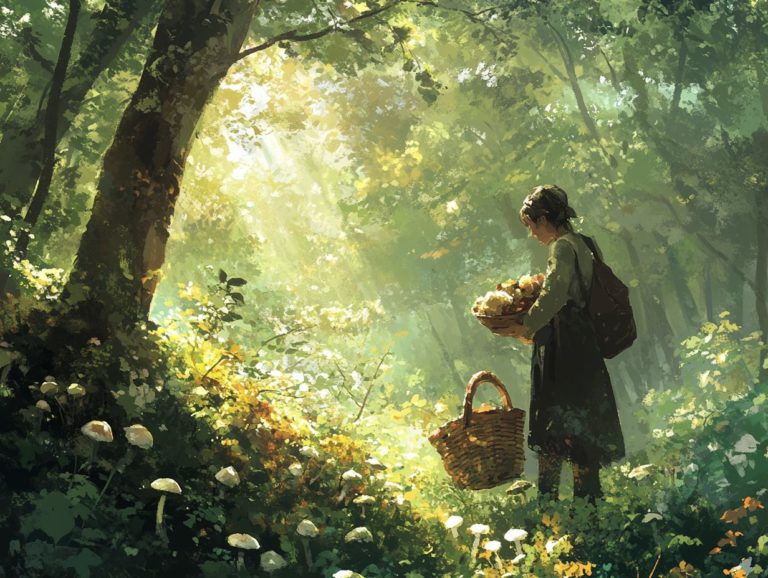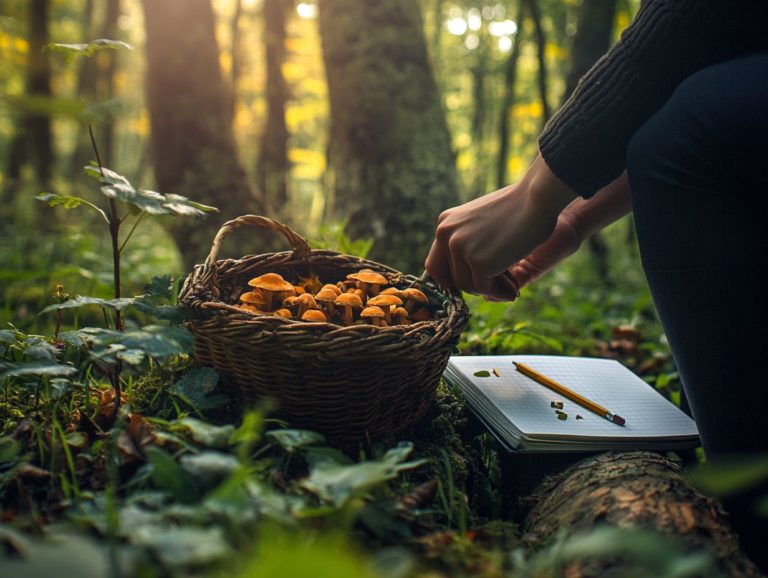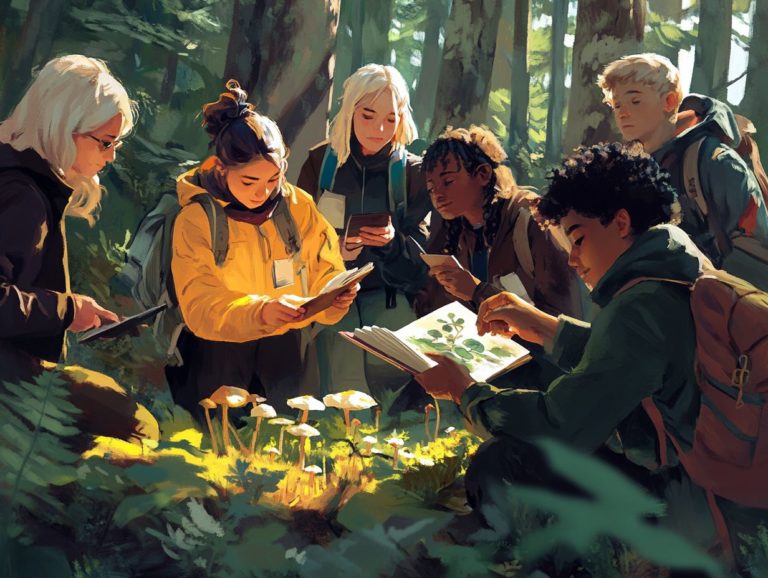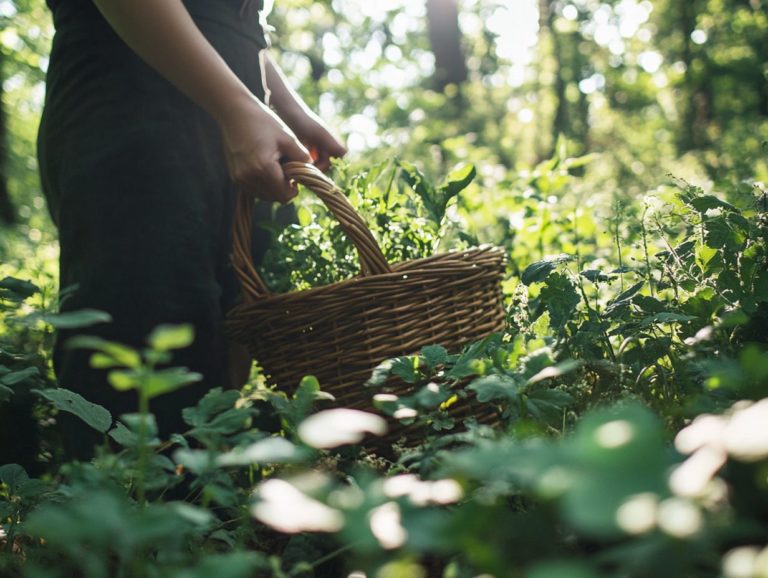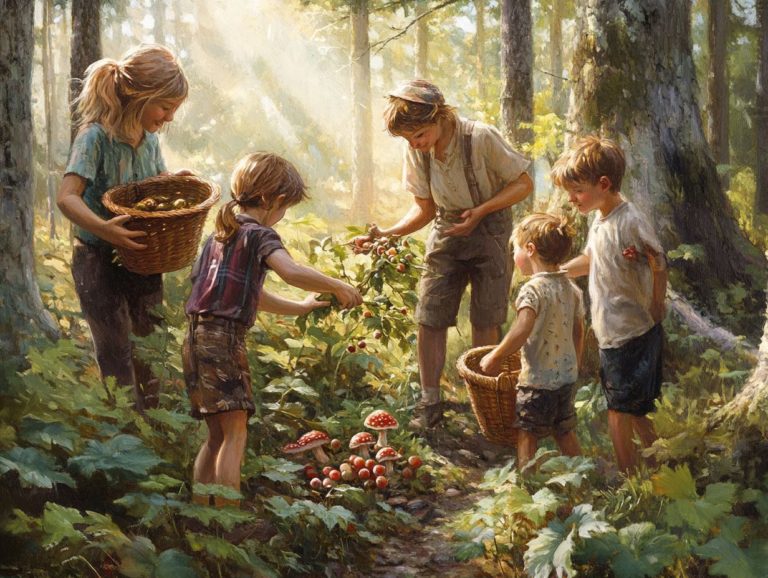Foraging Techniques for Nature Walks
Foraging is a time-honored tradition that deepens your connection to nature and elevates your culinary adventures, inviting you to explore the world of natural foods.
This article takes you on a journey through the fascinating realm of foraging, guiding you from the basics of what it entails to the art of identifying wild plants and fungi during your next stroll through the woods.
You will uncover essential tools and techniques for responsible harvesting. This ensures you navigate safely by steering clear of poisonous species while following foraging guidelines.
You will also find tasty wild food recipes to help you make the most of your foraged treasures. Prepare to embrace the rich bounty that nature has to offer!
Contents
- Key Takeaways:
- The Art of Foraging
- Identifying Edible Plants and Fungi
- Tools and Techniques for Foraging
- Staying Safe while Foraging
- Recipes and Cooking with Foraged Foods
- Frequently Asked Questions
- How can you forage during nature walks?
- Why learn foraging techniques for nature walks?
- What are common foraging techniques for nature walks?
- What safety precautions should you take while foraging?
- What resources can help you learn more about foraging techniques?
- Can you forage in urban areas during nature walks?
Key Takeaways:

- Discovering edible plants during nature walks is a fantastic way to connect with nature!
- Proper identification using field guides and expert guidance is crucial for safe and responsible learning to forage.
- Foraged foods can be used in various delicious and nutritious recipes, creating a unique and sustainable dining experience.
The Art of Foraging
The art of foraging invites you into a world where skill, knowledge, and a profound connection to nature converge. It enables you to explore the rich tapestry of wild plants and edible species, and learning how to develop your own foraging techniques can enhance your experience.
With roots steeped in indigenous wisdom and sustainability, foraging helps you understand the environment better and fosters community through shared experiences.
In regions like Idaho and Oregon, foraging enthusiasts embark on wild food adventures. These experiences deepen their botanical understanding and tracking skills, promoting environmental awareness through mindful harvesting practices.
What is Foraging?
Foraging is the art of scouring the wild for edible plants, fungi, and other natural treasures. It invites you to immerse yourself in local ecosystems and grasp the ecological niches these organisms occupy. Using foraging techniques to engage children can make this experience even more enriching.
More people are rediscovering this exciting ancient practice as they seek sustainable and healthful food options, particularly in herbal medicine and foraging from the wild plant community.
Among the various forms of foraging, wild mushroom hunting stands out. It offers a thrilling experience as you identify and gather exquisite species like porcini and chanterelles, transforming your culinary creations into something extraordinary.
This connection with nature enhances your diet and cultivates a genuine appreciation for biodiverse ecosystems, which are areas with many different types of plants and animals. Foraging fosters a symbiotic relationship with the environment, reminding you of your role in maintaining ecological balance and supporting nature families and local wildlife.
Ultimately, this enriching journey benefits not just your health but the well-being of our planet as a whole.
Benefits of Foraging on Nature Walks
Engaging in foraging during nature walks offers a wealth of benefits that go far beyond simply gathering edible plants. It fosters a deep connection with the environment, enhances community foraging experiences, and enriches your understanding of foraging techniques for urban environments and food sustainability.
Foraging can also boost your physical health by encouraging outdoor activities, promoting fitness through walking and exploring diverse habitats. The rewarding act of identifying and collecting wild edibles can elevate your confidence and cultivate mindfulness.
Participating in community workshops led by seasoned local foragers and local herbalists provides an invaluable opportunity to share knowledge about indigenous plants and their uses. You can also forge social bonds with fellow participants.
These gatherings not only sharpen your skills in sustainable harvesting but also ignite a shared passion for environmental awareness. They inspire you to appreciate the intricate relationship between humans and nature.
Start your foraging adventure today or join a local foraging group to connect with nature!
Identifying Edible Plants and Fungi
Identifying edible plants and fungi is an essential skill for successful foraging. It requires a solid understanding of plant structure and seasonal changes, enabling you to harvest safely and sustainably while respecting relationships among plants in the wild plant community.
This knowledge not only enhances your foraging experience but also deepens your connection to nature.
Common Edible Plants and Fungi
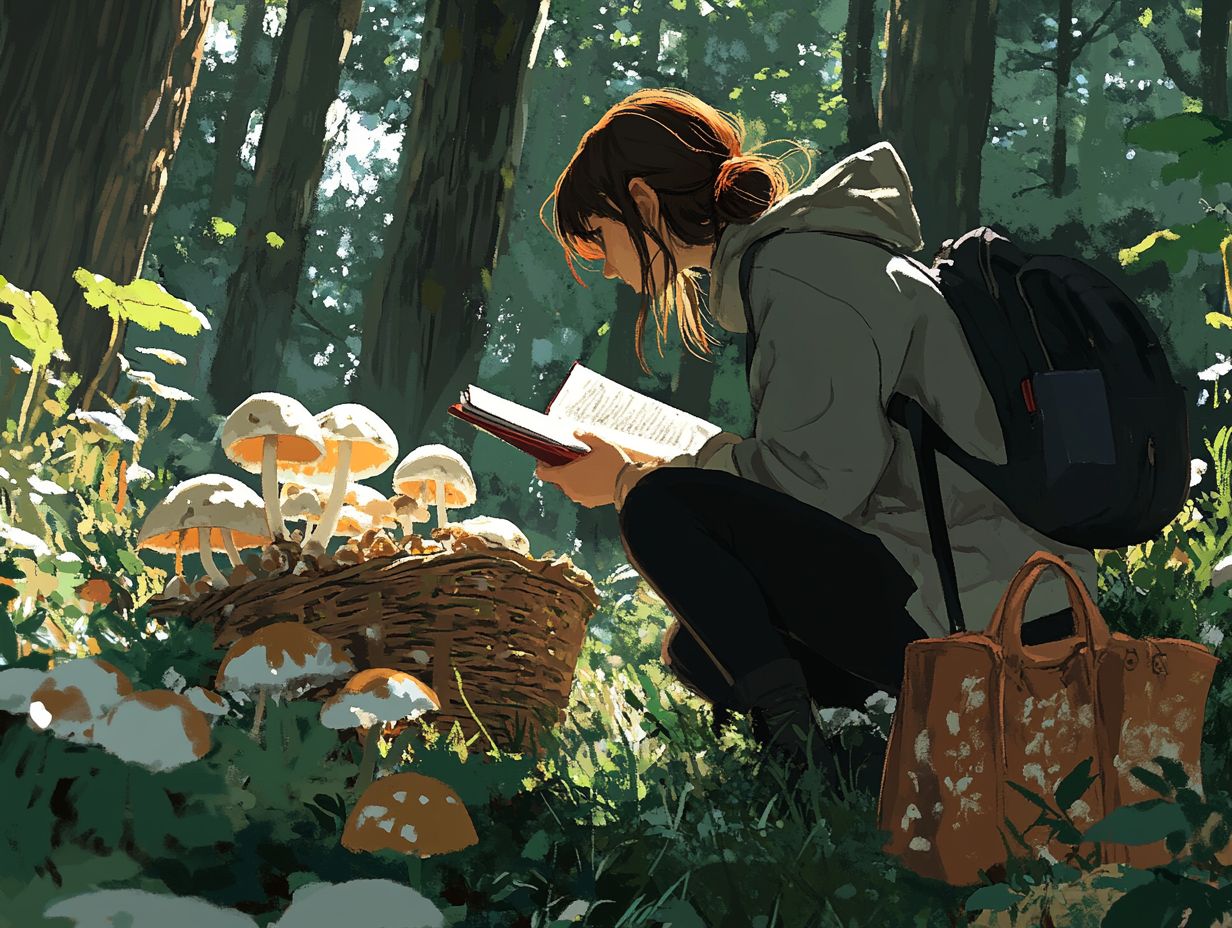
Join the adventure of foraging and discover nature s culinary secrets! You’ll uncover a treasure trove of common edible plants and fungi, including dandelions, wild garlic, and chanterelles.
Each of these offers a unique flavor profile and a wealth of nutritional benefits, perfect for those eager to master the art of foraging.
These plants not only elevate your culinary creations but also foster a profound connection to nature and promote a more sustainable lifestyle through nature exploration and cooking with plants.
Take dandelions, for example often dismissed as pesky weeds. You can use their leaves and flowers in salads or brew them into a refreshing tea, benefitting from a rich supply of vitamins A and C.
Wild garlic, with its fragrant leaves, serves as a delightful alternative to traditional garlic. It adds a burst of flavor to pesto or soups.
And let s not overlook chanterelles; their golden hue and delicate, fruity taste can transform dishes, from luxurious risottos to savory saut s.
Incorporating edible weeds and flowers like purslane and nasturtium not only infuses your meals with vibrant colors but also delivers impressive health benefits. They are essential companions for anyone exploring the culinary potential of wild foraging.
How to Properly Identify Edible Species
Properly identifying edible species is crucial for you as a forager. It requires keen attention to detail and a thorough understanding of safety guidelines to effectively distinguish between delightful edibles and dangerous poisonous plants.
To sharpen your identification skills, consult reliable resources like field guides or online databases that provide clear photographs and detailed descriptions of various species.
Attending herbal classes can be a fantastic way to immerse yourself in the fascinating world of plants, where both theory and hands-on experience come together seamlessly.
Learning from local herbalists gives you valuable insights into regional flora and helps cultivate a sense of community and shared knowledge.
Understanding botanical terms can significantly enhance your foraging trips. Always prioritize safety being cautious of look-alike plants is essential to ensure that each gathering is both enjoyable and risk-free.
Tools and Techniques for Foraging
Knowing the right tools and techniques makes foraging easier and more enjoyable. By honing these skills, you can embrace sustainable harvesting practices and learn foraging techniques for wilderness survival, enriching both your knowledge and your connection to nature.
Essential Tools for Foraging
The essential tools for your foraging adventures include baskets for gathering, knives for processing plants, and field guides for properly identifying wild edibles, all of which ensure a safe and successful experience.
A good pair of gloves will protect your hands from thorns and irritants, while a sturdy walking stick can help you navigate uneven terrain with ease.
Before you head out, consider having a plant press or drying rack on hand to preserve your botanical finds for later consumption or study. A compass or GPS device will enhance your navigation skills, allowing you to confidently explore new areas without losing your way.
Together, these tools not only streamline your foraging process but also significantly enhance the safety and efficiency of harvesting and preparing edibles.
Proper Techniques for Harvesting
Using the right techniques for harvesting is crucial. This respect for plant relationships promotes ecological interactions in the environment through foraging techniques.
By adopting methods like selective harvesting, you contribute to the longevity of various plant species. This means picking only some plants and leaving others to grow. Preserving their natural habitats is essential. Always leave enough plants behind to facilitate regeneration, allowing ecosystems to flourish and minimizing the risk of over-exploitation.
Understanding the intricate web of life surrounding these plants is essential; every organism plays a role in maintaining ecological balance.
Ethical foraging encourages mindfulness about your actions, fostering awareness of nature’s interconnectedness. It highlights the importance of preserving biodiversity for future generations.
Staying Safe while Foraging
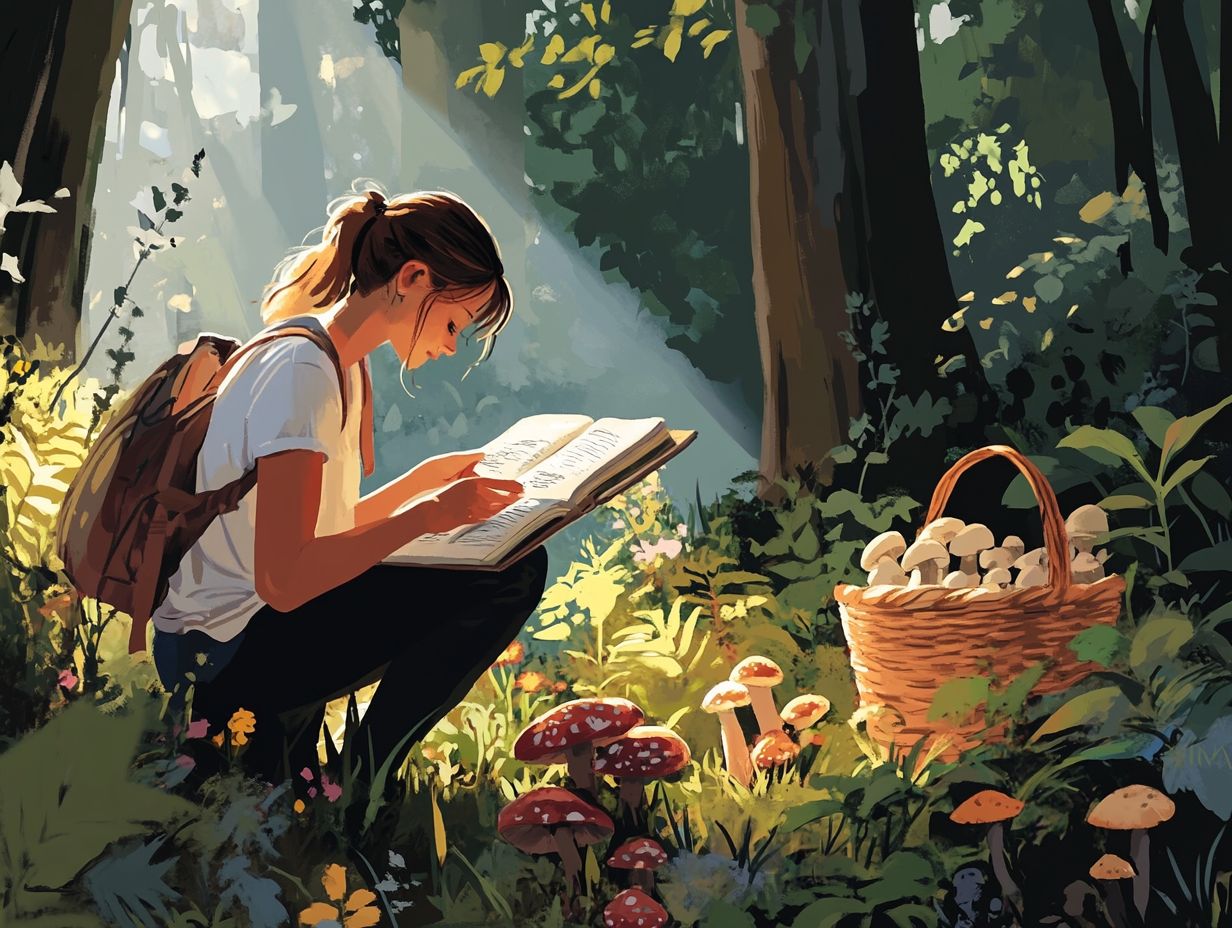
Staying safe while foraging is crucial. It requires good knowledge of how to avoid poisonous plants and a commitment to established foraging safety guidelines that protect both you and the environment.
Precautions to Take
Before you begin your foraging adventure, take precautions. Be selective about your locations and know the local plants.
Familiarize yourself with your surroundings. This knowledge enables you to identify both safe and hazardous plants confidently.
You can also engage with local foraging communities for support. These groups offer opportunities for shared experiences and invaluable tips that you may not find in any book.
Participating in guided foraging excursions enhances your experience. It helps you build a supportive network where you can discuss best practices and learn from one another’s encounters. This communal approach fosters safer practices, as members share insights about their favorite foraging spots, potential dangers, and foraging techniques for kids. Your journey into nature becomes enjoyable and secure.
Poisonous Plants and How to Avoid Them
Understanding poisonous plants and how to steer clear of them is essential for foraging safety. It hinges on your ability to accurately identify plants and grasp the ecological nuances of your local environment.
As you embark on your quest for foraged foods, equip yourself with the knowledge needed to distinguish between the edible and the toxic. Common poisonous plants like poison ivy, foxglove, and hemlock often resemble their safe counterparts. Precise identification is critical for your success in foraging.
Look for signs such as unusual leaf shapes, distinct flowers, and specific growth habitats. These clues can indicate toxicity. Educating yourself about these plants and engaging in ongoing research into local ecosystems is vital for anyone daring to venture into the wild.
By prioritizing safety and ecological awareness, you can explore nature s bounty with confidence and a deep respect for the environment.
Recipes and Cooking with Foraged Foods
Cooking with foraged foods invites you into a realm brimming with exquisite meal possibilities and innovative wild food recipes. This approach allows you to infuse your culinary creations with distinctive flavors sourced directly from nature while embracing techniques that promote food preservation.
Try out these recipes today and enjoy the unique flavors nature offers!
Delicious and Healthy Meal Ideas
Delicious and healthy meal ideas await you in the world of wild foods you can gather, like wild garlic, nettles, and edible flowers. Each offers a unique flavor and a host of health benefits.
By weaving these natural treasures into your everyday cooking, you can create vibrant dishes that tantalize your taste buds and enhance your well-being. Wild garlic, for instance, has a delightful aroma that makes it perfect for fragrant pesto or a rich soup, adding an earthy, garlicky twist to elevate any dish.
Nettles are packed with iron and can completely change a hearty risotto or be saut ed with olive oil for a simple yet elegant side. Edible flowers can turn an ordinary salad into a colorful masterpiece while providing essential vitamins.
Together, these wild foods do more than just enhance flavor they contribute significantly to a balanced diet. Celebrate nature’s bounty with every meal!
Frequently Asked Questions
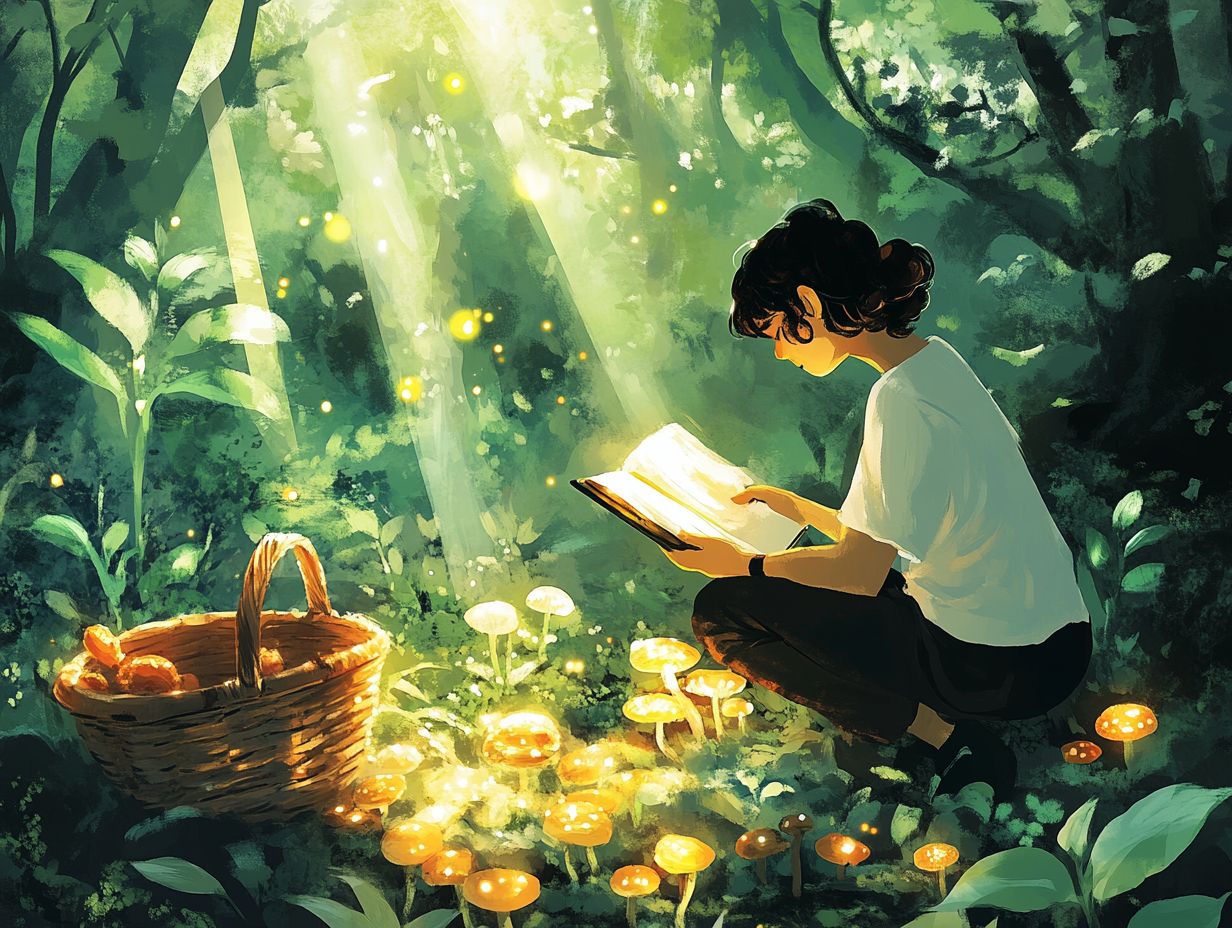
How can you forage during nature walks?
Foraging techniques involve identifying and gathering edible plants, nuts, berries, and other food sources found in the wild, making it essential for outdoor enthusiasts to learn effective foraging techniques.
Why learn foraging techniques for nature walks?
Learning these foraging techniques for plant identification helps you connect with nature, discover new plants, and can provide a sustainable food source.
What are common foraging techniques for nature walks?
Common techniques include identifying and harvesting edible plants, using tools like a knife or scissors, and using foraging techniques to connect with nature, as well as learning to prepare foraged items properly.
What safety precautions should you take while foraging?
It’s crucial to identify plants correctly before consuming them, as some can be poisonous. Also, forage in areas free from chemicals or pesticides.
What resources can help you learn more about foraging techniques?
Books, online articles, and workshops provide valuable information on safe and sustainable foraging in various environments.
Can you forage in urban areas during nature walks?
Yes! Many edible plants and food sources, like wild berries and some tree fruits, can be found in urban areas. Just be cautious and avoid places contaminated by pollutants.
Get out there and taste the delights of nature your next meal is waiting!

